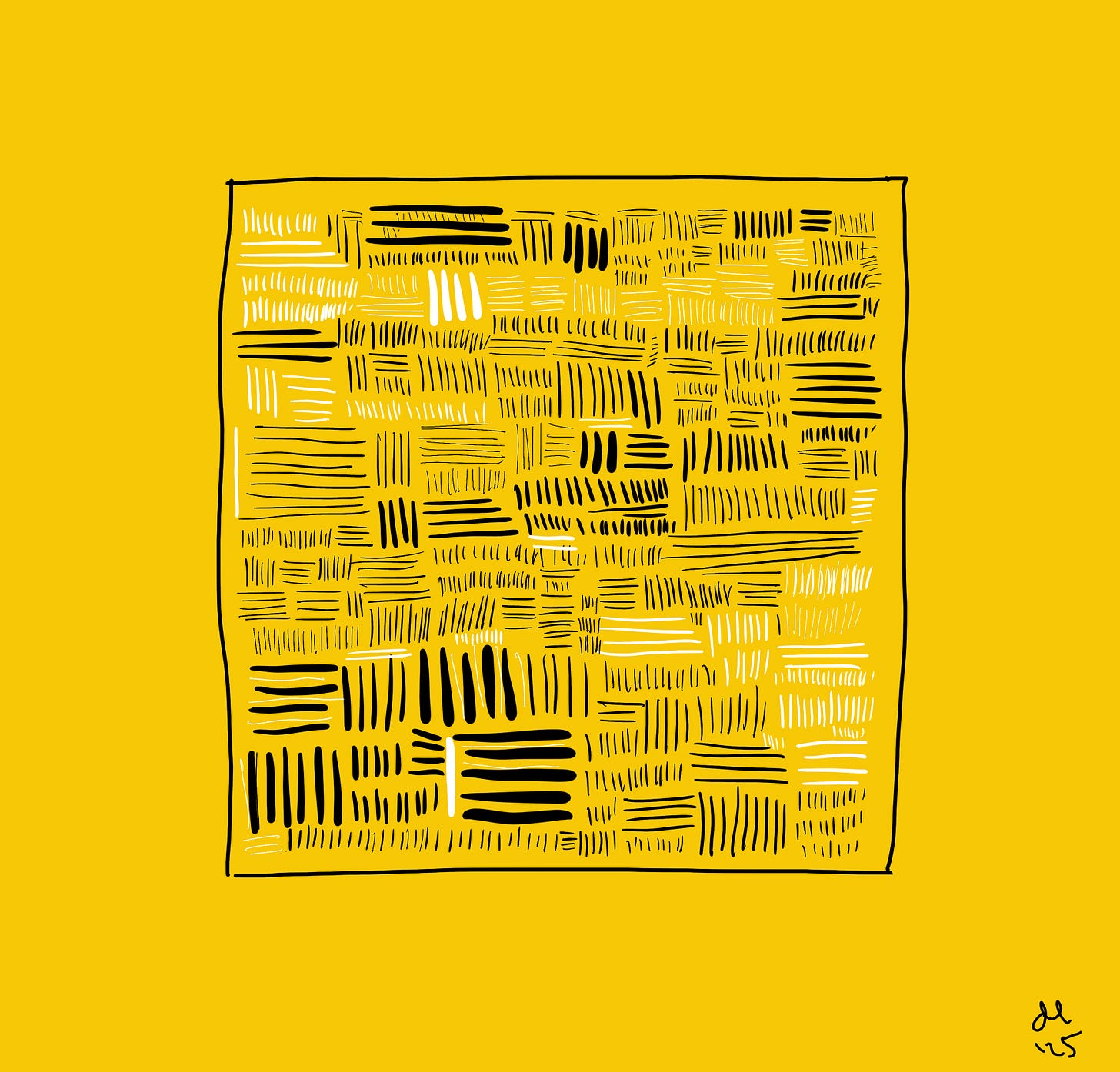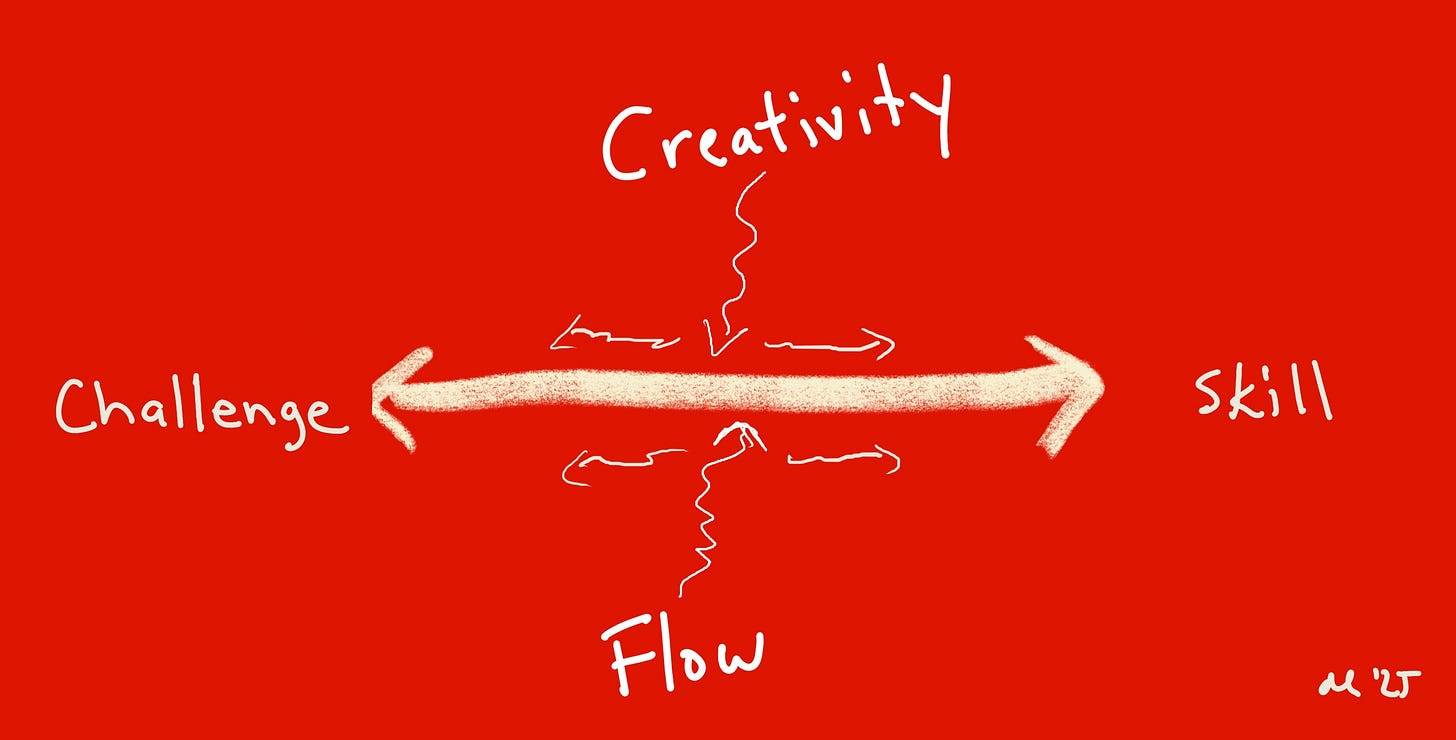Some Tough Love Truth About Creative Business Success (And Why You’re Probably Not Hearing It)
Box Cutter Co. Free Issue No. 87
You’ve seen the playbooks. The ones promising $10K/month…
(with 25-step funnels, AI content engines, and rapid growth hacks.)
Seems like maybe the $10k per month in “The Creator Economy “…has become the new 10,000 steps per day… silly metric.
(Both are largely arbitrary marketing gimmicks.)
After three years of building creative businesses from scratch, I’ve learned something these frequently-touted playbooks rarely say out loud:
👉 Success isn’t built on tactics alone.
In this multi-billion-dollar Creator Economy, sustainable success is built on mindset, creative orientation, and foundational systems.
The more these reflect your values — the stronger and more sustainable your enterprise and efforts. Here’s what that could look like. 👇
The Wild Leap (And What Followed)
I left the corporate rat race three years ago to build a creative business (or two) from scratch.
No investors. No playbook. No guarantees.
No financial runway. No clients.
Most people said I was nuts. (And… they weren’t wrong)
I didn’t leave because I had a perfect plan. I left because I knew I couldn’t stay. Toxicity in workplaces and silly office politics had worn me down — worn me out.
Walking away is not the expected path for a “mid-career professional” climbing the corporate ladder. After a decade of climbing that ladder, I’d almost tripled my salary, progressively moving higher in the corporate public sector.
But the ‘higher’ I moved in the corporate hierarchies and the bigger the budgets I managed, the more my soul shrivelled. The more I saw humanity shrink, too.
Walking away was a darn challenging choice. And yet, it remains one of the best decisions I’ve ever made.
Thus, in early April 2022, I started building something new, from scratch. Something far more fulfilling and soul-filling — and often damn scary.
The Struggles Weren’t What I Expected
My decision to leave was a family decision, but we also set some timelines and targets. (Leaving a six-figure salary with no contracts lined up is a pretty scary proposition for a family of 5 with a mortgage, some debts, etc.)
And yet, the challenges weren’t really what I initially expected. It was:
Not the clients.
Not the cash flow.
Not the daily writing or publishing.
The core challenges as one month moved into two, and two into three — and writing and posting daily. Studying everyone I could who’d had some success in this expanding “Creator Economy.”
Trying things.
Pondering the “niche down” advice, and POV and MVP and VIP, and bla, bla, bla…
None of these were the real challenge or issue.
It was the mindset traps tripping me up the most. (And it’s these that so few folks talk about in the usual materials, posts, and mini-courses)
The quiet psychological weight of a creative life and building something from scratch in this new, fascinating, and fantastic wealth of opportunities — in the purported $250 billion annual Creator Economy (estimated to double by 2027)
The “$10K Per Month” Playbook Mirage
Lately, another wave of $10K/month creator playbooks has been circulating social media channels (including here on Substack).
You’ve probably seen them:
Funnel formulas
AI content machines
25 “Secrets” to passive income
50-step monetization checklists
Sometimes there’s value inside. But often, they’re buffet-style hustle noise or they are long on hype, short on substance.
The harsh reality for most — especially those earlier in the foundation-building?
You don’t need a bigger funnel, a stronger magnet, or a clearer POV, or a ‘niche’.
Often, you just need clearer lenses.
What those playbooks almost always miss:
→ The psychological toll of constant visibility
→ The internal churn when metrics don’t move
→ The slow erosion of confidence in the frequent silence
And few warn you about how these eroding impacts sap momentum, and worse yet, your creativity.
Mindset: The Engine of Creative Businesses
After three years of engaging deeply in this “Creator Economy” gig — and an analytic, research-oriented approach to things — I’ve learned and realized a few things…
If you’re feeling a bit stuck in building your creative endeavours in these online spaces:
It’s probably not a strategy problem.
It’s certainly not a ‘niche’ challenge.
And, it’s definitely not a monetization model problem.
It’s most likely mindset tools, skills, and approaches.
I’m talking about the mindset skills keeping you going:
When your metrics are a month-long flatline,
When your posts are maestros for the crickets, and your ROI, such as time allocated to revenue earned, is a negative number (let alone a $0.03 per hour calculation, or less).
The mindset skills will steady you when the algorithm shrugs and the platform pivots (àla the writing and publishing platform Medium).
Early on in my journey of building from scratch, as things moved into month 5, month 6, several internal questions whispered (and sometimes shouted):
“Is this enough?”
“Is this working?”
“Were the doubters right?”
How the f**c^ am I going to make this work?
The Shift From Performing to Building
When I left the employment rat race, I had already spent over a decade “performing” in the public sector.
I knew what it meant to optimize for optics. To meet others’ expectations. To climb a ladder (built in old, outdated sets of systems).
So I made shifts. Big ones:
From chasing → to creating
From performing → to building
From output → to orientation (mind, soul, values)
From tracking metrics → to measuring what matters
Yet, these are easy to say and theorize — but much more difficult to put into daily practice.
Where My Creative Business Actually Works
“The Creator Economy” is a term now immersed in common dialogue, especially with over 5 billion souls globally accessing the Internet AND social media…
… it’s a space redefining careers, occupations, businesses and more.
Much of the over $250 billion US annually driving this ‘economy’ is in the Influencer space. Most people are familiar with the likes of Mr. Beast and the Kardashians, and so on.
These are primarily in the Business-to-Consumer (B2C) spaces. This is also the space where LinkedIn guru Justin Welsh operates, and many other build-on-social-media-types.
Lots of hype, big followings, sales funnels, go, go, go.
However, most of my current business and revenue lives in a sub-section of The Creator Economy, called: “The Business Creator Economy.”
(I prefer different terms: The Creative Economy and The Business Creative Economy)
This is where creativity meets and mingles with organizational and institutional systems.
Where thoughtful design rules over relentless sales funnels.
Where building leverage compounds over time.
Where quiet strategy may be key.
I still build and create in the B2C space, such as this newsletter, daily social media posts, and publishing on Medium.
(There’s also a growing C2C space: Creative to Creative, but that’s for another day)
Over the longer term, I see more of my trajectory in those spaces (B2C and C2C), for example, with books, courses, newsletters, etc.
But these days, most of my creative business revenues are driven within The Business Creative Economy.
And, there aren’t many flashy playbooks or guidebooks for this space. Because it’s not built for overnight returns and pretend get-rich-quick schemes.
It’s built for leverage.
For durability.
For long arcs.
Rather than trying to drive everyone and their dog to some ‘sales funnel’ or some ‘lead magnet’ or through relentless email sequences … to have 0.05% of those buy a $100 product.
Which you then need to sell 50-100 monthly to keep a business viable…
For example, selling 50 products in a month priced at $100 generates $5k in income. This means, to make the famed $10k/month, you would need to sell 100 products.
Or, here on Substack, to make that same amount, I’d need to have 1,000 paying subscribers at $5/month to make $5k. Or, $10/month to make $10k. And so on, and so on.
To do that requires having a very large audience, or a shit-tonne of paid ads, and so on.
These sorts of things are simply not built overnight. Not even in a year. Not in two. Probably not even in three.
Instead, I’m active in the B2B arena (The Business Creator Economy) where I bill at rates equivalent to selling multiple “low-ticket” (e.g. $100) products — in one day.
And these days, that means I only need a tiny audience. Theoretically, even just an audience of one (if it’s a business that’ll pay $10k per month, for example).
What I Do in The Business Creator Economy
Most of my creative business revenue comes from work that doesn’t fit into Influencer culture or the latest creator monetization trends.
I operate in a quieter corner of the Creator Economy, The Business Creator Economy. It’s where creative thinking and strategy meet organizational systems.
Where clarity, trust, and problem-solving matter much more than amassing followers or driving people to sales funnels and lead magnets.
Here’s what that looks like for me:
Ghostwriting, including newsletters, social media content, proposals, strategies, and communications for professionals, nonprofits, Indigenous organizations, and public agencies
Designing courses and learning experiences for academic institutions, non-profits, and professionals.
Consulting on education, workforce, and governance strategies.
Sometimes I charge by the hour. Sometimes by project. Sometimes on retainer. But the model is similar:
👉 Creative, strategic work solving real-world problems.
I don’t need to hustle 14 hours per day trying to amass an audience of 100,000 so that 0.05% will buy a $100 course from me (= $5K).
Meanwhile, I also quietly continue to build in the B2C — the more well-known components of The Creator Economy:
👉 Publishing regularly to build creative leverage and long-term visibility
👉 Building systems to compound—beyond one-time content or cash grabs
But this is my long game. Damn long game.
To build something meaningful and connected to your values — it won’t happen overnight.
How about You?
If you’re in the early days of your path, I suggest starting here: 👇
→ A rhythm of publishing
→ A clear, repeatable set of offers
→ Building a body of work that keeps working when you’re not
That’s how I’ve consistently surpassed $10K/month. Not through hype or hacks.
But by designing a business around what I do best, inside spaces that fit how I work, and more importantly, how I like to work and with whom I like to work with.
The Invisible Work That Actually Moves Your Needle
Much of what matters in creative business is invisible.
→ Quiet confidence
→ Momentum without burnout
→ A business aligned with your values
→ Writing that sharpens your thinking and attracts aligned projects
It’s not content.
It’s creative infrastructure. Creative ecosystems.
A body of work compounding over time.
A rhythm of presence, persistence and clarity.
A library of posts and articles, building trust without shouting and always selling.
What to Reflect On (If You’re Building Something To Last)
Creative business isn’t just a test of ideas. It’s a test of endurance, attention, and inner stability.
So instead of chasing better tactics this week, ask yourself (and write out):
What mindset trap do I keep circling back into?
What signal am I waiting for that I probably don’t need?
Where am I measuring progress based on someone else’s definition of success?
And then ask:
What’s one way I can re-commit to clarity over growth?
What would sustainability look like—not just financially, but emotionally?
Write these down.
Maybe stick them on a wall. Return to it when your energy wobbles.
👉 Because the tough love reality?
The biggest creative challenge is rarely the work.It’s believing the work matters—even before the results arrive.
⸻
If you’d like to learn more about some mindset tactics, and you haven’t already gone through it — I have a Free 5-day Educational Email Course:
Thanks for being here. Thanks for reading.
Have a question or comment? Please drop it here.
Like what you read? Consider sharing it. 👇






Thanks. Been at this 35 years now. Write on!